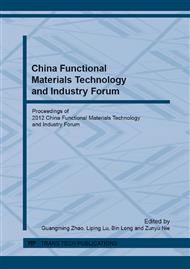[1]
D.D.L. Chung: Composites: Part B, Vol. 31 (2000), p.511.
Google Scholar
[2]
A. Harb: Renew Energ, Vol. 36 (2011), p.2641.
Google Scholar
[3]
S. Bhattacharjee, A.K. Batra and J. Cain: Green Streets and Highways 2010: An Interactive Conference on the State of the Art and How to Achieve Sustainable Outcomes Proceedings of the Green Streets and Highways 2010 Conference (Denver. Colorado, 2011) p.258.
DOI: 10.1061/41148(389)22
Google Scholar
[4]
L. Bell: Science, Vol. 321(2008) No.5895, p.1457.
Google Scholar
[5]
D.D.L. Chung: Carbon, Vol. 50 (2012), p.3342.
Google Scholar
[6]
M.Q. Sun, Z.Q. Li, Q.Z. Mao and D.R. Shen: Cement Concrete Res, Vol. 29 (1999), p.769.
Google Scholar
[7]
S.H. Wen and D.D.L. Chung: Cement Concrete Res, Vol. 29 (1999), p.1989.
Google Scholar
[8]
J.Y. Cao and D.D.L. Chung: Cement Concrete Res, Vol. 35 (2005), p.810.
Google Scholar
[9]
H.Y. Cao, W. Yao and J.J. Qin: Adv Mater Res, Vol. 177 (2011), p.566.
Google Scholar
[10]
S.H. Wen and D.D.L. Chung: Cement Concrete Res, Vol. 34 (2004), p.2341.
Google Scholar
[11]
B. Demirel and S. Yazicioglu: New Carbon Mater, Vol. 23 (2008) No.1, p.21.
Google Scholar
[12]
W.Y. Zhao, W.F. Zhang, C.H. Ma, Y.J. Cai and D.R. Zhu: Journal of Daqing Petroleum Institute,Vol. 32 (2008), p.83 (In Chinese).
Google Scholar
[13]
Z.Q. Tang, C.F. Tong, J.S. Qian and Z. Wang: Journal of Chongqing Jianzhu University, Vol. 30 (2008), p.125 (In Chinese).
Google Scholar
[14]
S.H. Wen and D.D.L. Chung: Carbon, Vol. 40 (2002), p.2495.
Google Scholar
[15]
D.D. Pollock: Thermoelectricity: Theory, Thermometry, Tool (ASTM Special Technical Publication 852, Philadelphia, United States of America, 1985) p.121.
Google Scholar
[16]
J.R. Sootsman, D.Y. Chung and M.G. Kanatzidis: Angew Chem Int Ed, Vol. 48 (2009), p.8616.
Google Scholar
[17]
M. Ohtaki, D. Ogura, K. Eguchi and H. Arai: J Mater Chem, Vol. 4 (1994), p.653.
Google Scholar
[18]
G. M. Beensh-Marchwicka, E. Prociow and W. Mielcarek: Cryst Res Technol, Vol. 36 (2001), p.1035.
Google Scholar
[19]
S. Iwanaga, M. Marciniak, R.B. Darling and F.S. Ohuchi: J Appl Phys, Vol. 101 (2007), p.23709.
Google Scholar


